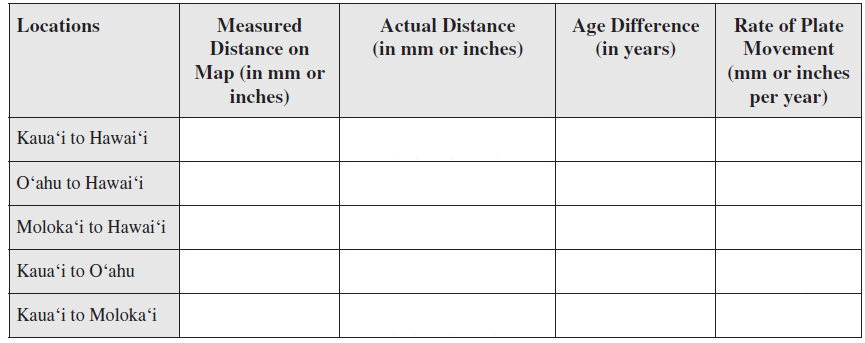Discuss the particular dangers posed by volcanic hazards due to the Campi Flegrei in Italy
What will be an ideal response?
ANSWER: A successful answer should include at least three of the following issues:
- The Campi Flegrei is an active resurgent caldera.
- The area has shown frequent and dramatic rising and sinking over a long period.
- The caldera is populated by two million people, making the potential loss of life extreme.
- Evacuation of the area would take considerable amounts of time due to the size of the population and available transportation.
- Past eruptions have deposited enough ash in nearby areas to collapse almost any roof.
- Previous eruptions have involved rhyolitic pyroclastic flows, which are extremely hazardous?
You might also like to view...
Complete the chart below.
Using the map of the Hawaiian Islands and the ages of the basaltic lava (Figure 33-4), compute the approximate rate of movement of the Pacific Plate as it passes over the Hawaiian hot spot.
You will compare the age and distance between several different volcanoes on the islands. The ages of volcanic rocks on the islands are given in millions of years. White dots on the islands mark the location of a volcano. For example, on the island of Hawai‘i, the dot next to “0.0” marks the location of the currently active volcano, K?-lauea.
In this exercise, you will compare Hawai‘i (0.0 years—currently active volcanoes), Moloka‘i (1.9 million years), O‘ahu (3.7 million years), and Kaua‘i (5.1 million years). For the purposes of this exercise, we will take the position of the K?-lauea volcano to represent the location of the Hawaiian hot spot (keep in mind that this is a simplistic assumption). We also assume that the Hawaiian hot spot is completely stationary over long periods of time.
(a) First, determine the distance between each pair of locations listed on the chart. With a ruler, carefully measure the distance between locations on the map to the nearest millimeter if you use S.I. units and to the nearest 1/16 inch if you use English units. If you use English units, convert fractions of inches to decimals to make other calculations easier (for example, 11>8 = 1.125). This figure is the “Measured Distance on Map.” Then multiply this measured distance on the map by 4,200,000 (the denominator of the fractional map scale) to determine the “ Actual Distance” in millimeters (or inches).
(b) Next, determine the “Age Difference” in years between each pair of locations. (Be sure to include the correct number of zeros in your figure.)
(c) Finally, divide the “Actual Distance” between locations by the “Age Difference” to estimate the rate of plate movement in millimeters (or inches) per year.

Marker-assisted breeding allows
A) desired bacterial genes to be inserted into crops. B) beneficial animal genes to be inserted into crops. C) crop improvements without resorting to transgenic traits. D) plants that have been bioengineered to be easily identified in the field.
You are an avid skier. What factors should you be sensitive to when skiing to avoid avalanche hazards?
What will be an ideal response?
Why is it critically important to develop and implement sustainable management approaches for Grand Banks fisheries?
What will be an ideal response?